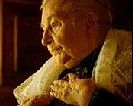When the new Slovanský dům (Slavic House) ten-screen multiplex cinema opened in central Prague on 6 December last year, the premiere of F A Brabec's new film, Kytice (Bouquet, 2000) was chosen for the opening night. The premiere's venue of this cathedral of film commercialism tells us much about the substance the film.
Kytice is an adaptation of a collection of poetry under the same title, written by Karel Jaromír Erben in 1853. These poetic stories belong to the "national treasure" of 19th-century Czech literature, along with Mácha's Máj (May) and Němcová's Babička (Grandmother). The literary quality of these works and the general awareness of the stories among Czech people gives them appeal for creators from different fields of art.
Director F A Brabec, is mostly known as a extremely adept cameraman, who has a highly developed sense for the beauty of a picture, for the unison of colors and the impression of light. As a cameraman, he co-operated with directors such as Irena Pavlásková on her film Čas sluhů (Time of the Servants, 1989), and with Jan Svěrák on his films Obecná škola (Elementary School, 1992), Akumulátor 1 (Accumulator 1, 1994) and Jízda (Ride, 1994), and with controversial personality and 1960s film legend Jan Němec on the project Jméno kódu Rubín (Code Name: Ruby, 1997).
Creatures, parody and grotesque principles
The film Kytice contains seven stories (the actual collection included twelve poems) that take the audience into the world of folk tales. 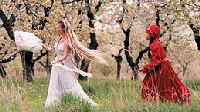 Often the short stories end in a final, inevitable catastrophe. Creatures, cruelty and love are the basic components of the old mystic world of Czech narrative presented on the film screen.
Often the short stories end in a final, inevitable catastrophe. Creatures, cruelty and love are the basic components of the old mystic world of Czech narrative presented on the film screen.
A different world opens up in front of our eyes and we can watch all the creatures of the old tales, such as the vodník, the polednice and creatures like zombies, being depicted with creativity and invention.
A vodník in Czech folklore is a mysterious character who lives underwater as a creature lost between dark evil and the positive human feelings of love and sorrow. In this episode we see a young girl drowning in a pond, the Kingdom of Vodník. The creature (played by Dan Bárta) saves her life but keeps her, and soon also their baby, under the water. When the girl visits her mother on land for the first time, it is close to catastrophe.
The scenes showing the vodník's underwater world were shot without computer-generated effects and consequently attracted a lot of attention from the Czech media. The unusual way of underwater filming was successful and brought effective pictures, but the final scenes are too long to keep the viewer's attention and interest.
Horror and laughter
In the story Polednice we meet a different kind of creature, a daytime ghost who comes for disobedient children at noon. Polednice (Bolek 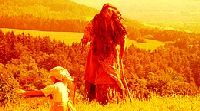 Polívka) comes from the shaken up hot summer air with a grotesque slowness. In a cottage, an angry and tired mother says words that will fatefully determine the future of her child. The general yellow tinge of the picture makes the atmosphere of a hot summer day very intensive and brings a kind of understanding for the exhausted mother (Zuzana Bydžovská). In contrast to the Vodník episode, Polednice shows us a more creative side to the director.
Polívka) comes from the shaken up hot summer air with a grotesque slowness. In a cottage, an angry and tired mother says words that will fatefully determine the future of her child. The general yellow tinge of the picture makes the atmosphere of a hot summer day very intensive and brings a kind of understanding for the exhausted mother (Zuzana Bydžovská). In contrast to the Vodník episode, Polednice shows us a more creative side to the director.
The basic principle that makes the story interesting is a parody. The character of the polednice is depicted with a grotesque sense for the narrow boundaries between comedy and tragedy, fear and laughter, and reality and fantasy.
The principles of grotesque and parody, however, are fully developed in the next story, Svatební košile (The Wedding Blouse). The main character of 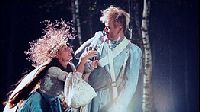 this tale is a dead soldier (Karel Roden) who comes for his fiancée (Klára Sedláčková) from the grave. The creation of this "zombie" is made with a satiric distance that shows the creature with puppet-like movements while still preserving the grotesque effect, thus uniting the comic and tragic moments.
this tale is a dead soldier (Karel Roden) who comes for his fiancée (Klára Sedláčková) from the grave. The creation of this "zombie" is made with a satiric distance that shows the creature with puppet-like movements while still preserving the grotesque effect, thus uniting the comic and tragic moments.
One of the most wonderful and clearly satiric moments of this episode is the scene where the fiancée is hidden in the mortuary with a dead body and she is threaten by the dead lover from outside. The poor dead man lying in the mortuary (Jiří Schmitzer) is alternately woken up by Satan's words uttered to help the creature kill the girl and then suddenly sent back to "sleep" by the prayer of the fiancée. The satirical point of view in these scenes is entirely successful as the director's artistic conception of poetic verse, artistic pictures, great acting and grotesque styles match and complement each other.
Another moment of parody can be seen in the poem Zlatý Kolovrat (The Gold Spinning Wheel). The story about two sisters, one beautiful and kind the other ugly and bad, is the only tale in Kytice with a happy ending. The pretty sister was cut into pieces by her mother and sister in law to get a certain 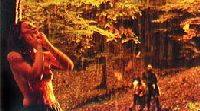 king's love and more importantly, his gold. A grotesque effect is more than evident, especially in the business of exchanging the severed hands and legs and dislodged eyeballs of the dead beauty for a gold spinning-wheel.
king's love and more importantly, his gold. A grotesque effect is more than evident, especially in the business of exchanging the severed hands and legs and dislodged eyeballs of the dead beauty for a gold spinning-wheel.
Unfortunately, this grotesque effect is weakened by a "poetic atmosphere" made by beautiful pictures of an autumn forest with all its wonderful colors, effective repeated movements and a boringly long joke of a king riding his horse.
The grotesque principle returns at the very end of the film for a carnivalesque dance of masks, where all the different characters together are the members of the wonderful grotesque celebration.
Beauty, beauty, beauty...
The short shots presented in the preview of the film remind us of the poetic style and beauty of the pictures well-known from the films of Slovak director Juraj Jakubisko. Interestingly, he co-operated on Kytice as a "supervisor" and producer along with his wife Deana Jakubisková (J & J Jakubisko Films). Jakubisko, as a director, has a great sense for the artistic creation of each picture that can call up, along with the story, strong emotions in the spectator.
Brabec, on the other hand, takes perfect shots with the same artistic sense for the quality of a picture, but the final result on the screen seems to have 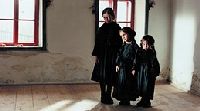 no significant impact on the audience. While Jakubisko is a great teller of film stories, and uses the artistic pictures to firm up the sense of the story, he works solely with the artistic creation of pictures, which often stand in deep contrast to the simple construction of the verses of K J Erben.
no significant impact on the audience. While Jakubisko is a great teller of film stories, and uses the artistic pictures to firm up the sense of the story, he works solely with the artistic creation of pictures, which often stand in deep contrast to the simple construction of the verses of K J Erben.
The whole film has the superficial gloss of a perfect picture. Every shot is beautiful, taken from the perfect angle in perfect colors and light. It is as perfect as only a commercial can be. Such "commercial perfectionism" probably came from the large experience of the director, who has made about 150 commercials and many video clips for famous Czech pop-stars.
Kytice is not Brabec's first attempt at directing a feature film.

|
The absurd story of Král Ubu did not reach the Czech audience and the final result took the form of an interesting "artistic experiment." As if to remedy this, Kytice is adapted from a poetic text which is far more well-known to Czech audiences. Even so, the final effect is very similar to that of Král Ubu.
In essence, Kytice was shot, directed, and produced as would a long series of commercials. Flying white blossoms surrounding a young innocent girl, shiny red apples on the lap of a worried mother, colorful leaves in an autumn forest, and everything reminds the world of hard commercialism more than poetic symbolism. Everything looks more artificial than artistic, and the effort for effect is just simply too obvious.
Ivana Košuličová, 28 January 2001
- Kinoeye Archive of articles on Central and East European cinema
- Browse through the CER eBookstore for electronic books
- Buy English-language books on Central and East European cinema through CER
- Return to CER front page



